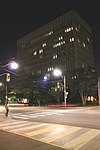Borden Buildings
Dairy buildingsDairy farming in CanadaIndustrial buildings completed in 1909University of Toronto buildings

The Borden Buildings are two buildings located at 563 Spadina Crescent and 487 Spadina Crescent in Toronto, Ontario, Canada. They were once home to dairy operations and now are used by the University of Toronto. The two buildings were constructed in 1909 (1909) by architect George Martell Miller for City Dairy Company Limited, which was later acquired by Borden Dairy for their Canadian operations. The buildings were also referred to as City Dairy Stables and are now known as Borden Building South (487 Spadina Cr) and Borden Building North (563 Spadina Cr).
Excerpt from the Wikipedia article Borden Buildings (License: CC BY-SA 3.0, Authors, Images).Borden Buildings
Helga and Mike Schmidt Performace Terrace, Toronto
Geographical coordinates (GPS) Address Website Nearby Places Show on map
Geographical coordinates (GPS)
| Latitude | Longitude |
|---|---|
| N 43.660277777778 ° | E -79.4 ° |
Address
University of Toronto (University of Toronto - St. George Campus)
Helga and Mike Schmidt Performace Terrace
M5S 2E5 Toronto
Ontario, Canada
Open on Google Maps





